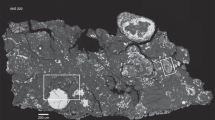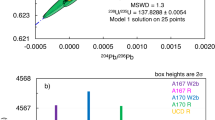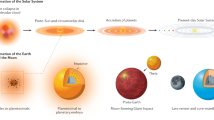Abstract
Our Solar System formed ∼4.6 billion years ago from the collapse of a dense core inside an interstellar molecular cloud. The subsequent formation of solid bodies took place rapidly. The period of <10 million years over which planetesimals were assembled can be investigated through the study of meteorites1,2,3. Although some planetesimals differentiated and formed metallic cores like the larger terrestrial planets, the parent bodies of undifferentiated chondritic meteorites experienced comparatively mild thermal metamorphism that was insufficient to separate metal from silicate4,5. There is debate about the nature of the heat source6,7,8,9 as well as the structure and cooling history of the parent bodies10,11,12. Here we report a study of 244Pu fission-track and 40Ar–39Ar thermochronologies of unshocked H chondrites, which are presumed to have a common, single, parent body. We show that, after fast accretion, an internal heating source (most probably 26Al decay8,9,10,13) resulted in a layered parent body6 that cooled relatively undisturbed: rocks in the outer shells reached lower maximum metamorphic temperatures and cooled faster than the more recrystallized and chemically equilibrated rocks from the centre, which needed ∼160 Myr to reach 390K.
This is a preview of subscription content, access via your institution
Access options
Subscribe to this journal
Receive 51 print issues and online access
$199.00 per year
only $3.90 per issue
Buy this article
- Purchase on Springer Link
- Instant access to full article PDF
Prices may be subject to local taxes which are calculated during checkout



Similar content being viewed by others
References
Chen, J. H. & Wasserburg, G. J. The isotopic composition of uranium and lead in Allende inclusions and meteoritic phosphates. Earth Planet. Sci. Lett. 5, 15–21 (1981)
Allègre, C. J., Manhès, G. & Göpel, C. The age of the Earth. Geochim. Cosmochim. Acta 59, 1445–1456 (1995)
Lugmair, G. W. & Galer, S. J. G. Age and isotopic relationships among the angrites Lewis Cliff 86010 and Angra dos Reis. Geochim. Cosmochim. Acta 56, 1673–1694 (1992)
van Schmus, W. R. & Wood, J. A. A chemical-petrologic classification for the chondritic meteorites. Geochim. Cosmochim. Acta 31, 747–765 (1967)
Dodd, R. T. Metamorphism of the ordinary chondrites: a review. Geochim. Cosmochim. Acta 33, 161–203 (1969)
Herndon, J. M. & Herndon, M. A. Aluminium-26 as a planetoid heat source in the early solar system. Meteoritics 12, 459–465 (1977)
Wood, J. A. & Pellas, P. in The Sun in Time (eds Sonett, C. P., Giampapa, M. S. & Matthews, M. S.) 741–760 (Univ. of Arizona Press, Tucson, 1991)
Lee, T., Papanastassiou, D. A. & Wasserburg, G. W. Demonstration of 26Mg excess in Allende and evidence for 26Al. Geophys. Res. Lett. 3, 109–112 (1976)
Knodlseder, J., Cervino, M., Le Duigou, J. M., Meynet, G., Schaerer, D. & von Ballmoos, P. Gamma-ray line emission from OB associations and young open clusters–II. The Cygnus region. Astron. Astrophys. 390, 945–960 (2002)
Miyamoto, M., Fujii, N. & Takeda, H. Ordinary chondrite parent body: an internal heating model. In Proc. Lunar Planet. Sci. Conf. 12B, 1145–1152 (1981)
Scott, E. R. D. & Rajan, R. S. Metallic minerals, thermal histories and parent bodies of some xenolithic, ordinary chondrite meteorites. Geochim. Cosmochim. Acta 45, 53–67 (1981)
Grimm, R. E. Penecontemporaneous metamorphism, fragmentation, and reassembly of ordinary chondrite parent bodies. J. Geophys. Res. 90(B2), 2022–2028 (1985)
Zinner, E. & Göpel, C. Aluminum-26 in H4 chondrites: implications for its production and its usefulness as a fine-scale chronometer for early solar system events. Meteoritics Planet. Sci. 37, 1001–1013 (2002)
Wood, J. A. The cooling rates and parent planets of several iron meteorites. Icarus 3, 429–459 (1964)
Taylor, G. J., Maggiore, P., Scott, E. R. D., Rubin, A. E. & Keil, K. Original structures, and fragmentation and reassembly histories of asteroids: evidence from meteorites. Icarus 69, 1–13 (1987)
Jordan, J., Kirsten, T. & Richter, H. 129I/127I: a puzzling early solar system chronometer. Z. Naturforsch. 35(a), 145–170 (1980)
Cherniak, D., Lanford, W. A. & Ryerson, F. J. Lead diffusion in apatite and zircon using ion implantation and Rutherford backscattering techniques. Geochim. Cosmochim. Acta 55, 1663–1673 (1991)
Göpel, C., Manhès, G. & Allègre, C. J. U–Pb systematics of phosphates from equilibrated ordinary chondrites. Earth Planet. Sci. Lett. 121, 153–171 (1994)
Pellas, P., Fieni, C., Trieloff, M. & Jessberger, E. K. The cooling history of the Acapulco meteorite as recorded by the 244Pu and 40Ar–39Ar chronometers. Geochim. Cosmochim. Acta 61, 3477–3501 (1997)
Turner, G., Enright, M. C. & Cadogan, P. H. The early history of chondrite parent bodies inferred from 40Ar–39Ar ages. Proc. Lunar Planet. Sci. Conf. 9, 989–1025 (1978)
Lavielle, B., Marti, K., Pellas, P. & Perron, C. Search for extinct 248Cm in the early Solar System. Meteoritics 27, 382–386 (1992)
Steiger, R. H. & Jäger, E. Subcommission on Geochronology: convention on the use of decay constants in geo- and cosmochronology. Earth Planet. Sci. Lett. 36, 359–362 (1977)
Renne, P. R. 40Ar/39Ar age of plagioclase from Acapulco meteorite and the problem of systematic errors in cosmochronology. Earth Planet. Sci. Lett. 175, 13–26 (2000)
Begemann, F. et al. Call for an improved set of decay constants for geochronological use. Geochim. Cosmochim. Acta 65, 111–121 (2001)
Trieloff, M., Jessberger, E. K. & Fiéni, C. Comment on ‘40Ar/39Ar age of plagioclase from Acapulco meteorite and the problem of systematic errors in cosmochronology’ by Paul R. Renne. Earth Planet. Sci. Lett. 190, 267–269 (2001)
Brazzle, R. H., Pravdivtseva, O. V., Meshik, A. P. & Hohenberg, C. M. Verification and interpretation of the I–Xe chronometer. Geochim. Cosmochim. Acta 63, 739–760 (1999)
Pravec, P. & Harris, A. W. Fast and slow rotation of asteroids. Icarus 148, 12–20 (2000)
Pellas, P. & Storzer, D. Mesures des taux de refroidissement des chondrites ordinaires à partir des traces de fission du plutonium 244 enregistrées dans les cristaux détecteurs. C. R. Acad. Sci. III D 280, 225–228 (1975)
Trieloff, M., Deutsch, A. & Jessberger, E. K. The age of the Kara impact structure, Russia. Meteoritics Planet. Sci. 33, 361–372 (1998)
Schaeffer, G. A. & Schaeffer, O. A. 40Ar–39Ar ages of lunar rocks. Proc. Lunar Planet. Sci. Conf. 8, 2253–2300 (1977)
Acknowledgements
We thank B. Dominik for mineral separation, A. Bouikine and E. Korotchantseva for assisting in 40Ar–39Ar analyses, and D. Stöffler for shock-stage classification of some H chondrites. We appreciate discussions with J.A. Wood, E. Anders and T. Althaus, and support from R. Altherr, T. Kirsten and K. Mauersberger at various stages of this study. M.T., E.K.J. and J.H. acknowledge support from the Deutsche Forschungsgemeinschaft.Author contributions P.P. provided the motivation for this research by his enthusiastic work on 244Pu fission-track studies.
Author information
Authors and Affiliations
Corresponding author
Ethics declarations
Competing interests
The authors declare that they have no competing financial interests.
Supplementary information
Rights and permissions
About this article
Cite this article
Trieloff, M., Jessberger, E., Herrwerth, I. et al. Structure and thermal history of the H-chondrite parent asteroid revealed by thermochronometry. Nature 422, 502–506 (2003). https://doi.org/10.1038/nature01499
Received:
Accepted:
Issue Date:
DOI: https://doi.org/10.1038/nature01499
This article is cited by
-
Wurtzite and fluorite ferroelectric materials for electronic memory
Nature Nanotechnology (2023)
-
Analytical protocols for Phobos regolith samples returned by the Martian Moons eXploration (MMX) mission
Earth, Planets and Space (2021)
-
Natural and experimental high-pressure, shock-produced terrestrial and extraterrestrial materials
Progress in Earth and Planetary Science (2021)
-
Diverse electronic and magnetic properties of CrS2 enabling strain-controlled 2D lateral heterostructure spintronic devices
npj Computational Materials (2021)
-
Precometary organic matter: A hidden reservoir of water inside the snow line
Scientific Reports (2020)
Comments
By submitting a comment you agree to abide by our Terms and Community Guidelines. If you find something abusive or that does not comply with our terms or guidelines please flag it as inappropriate.



